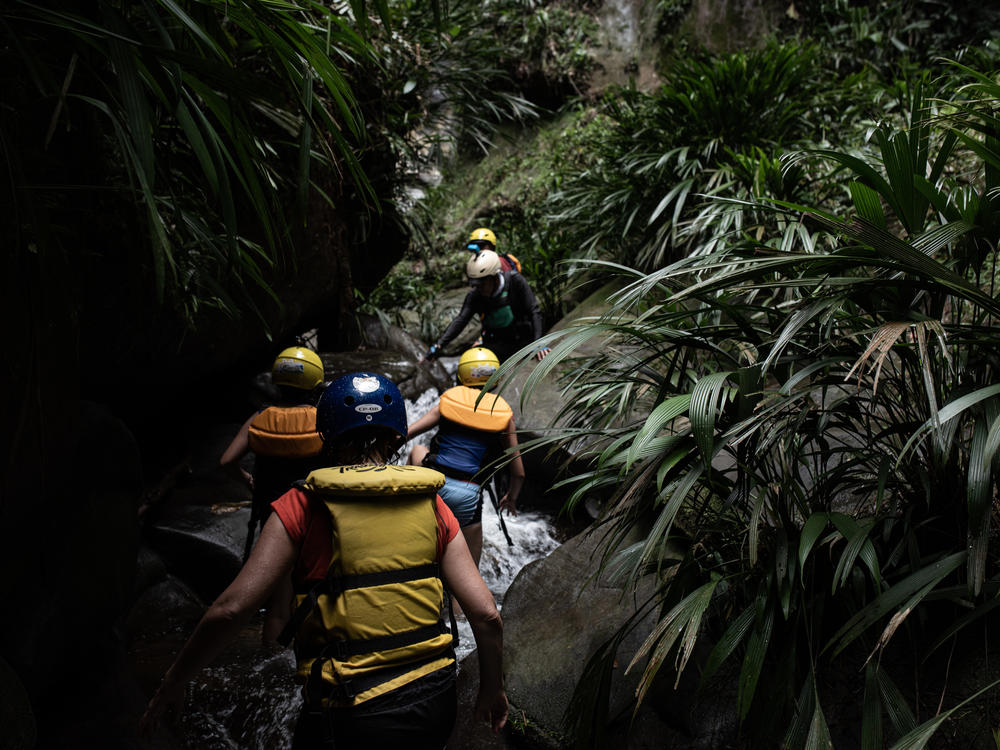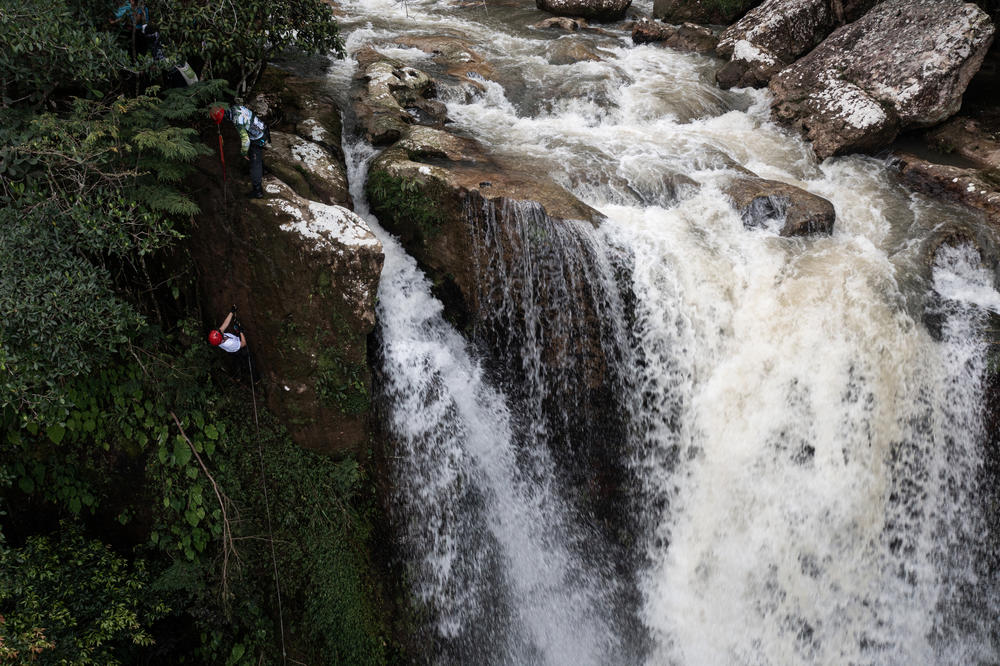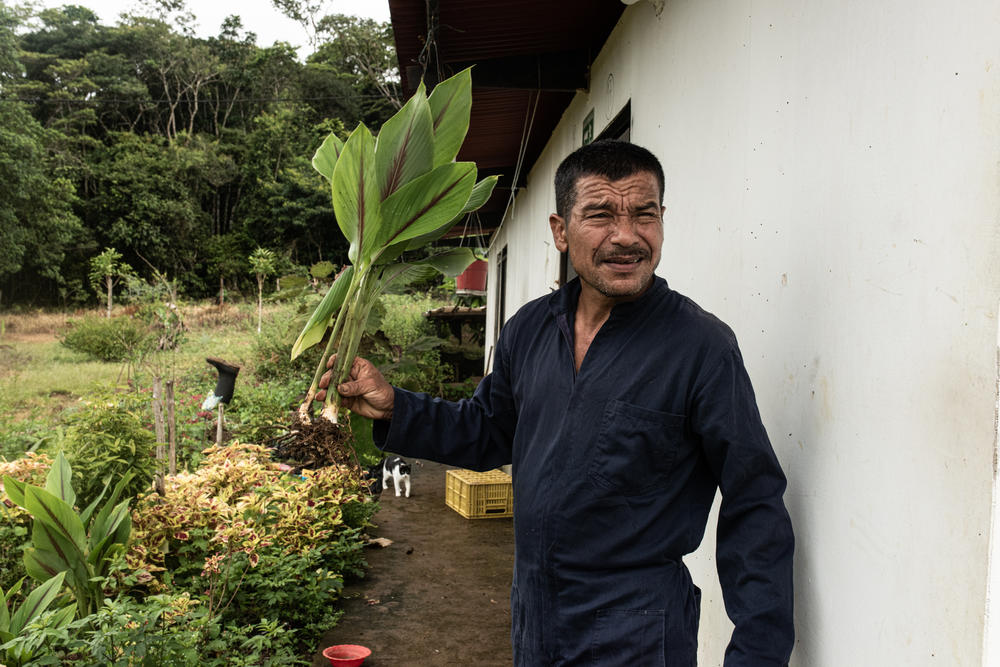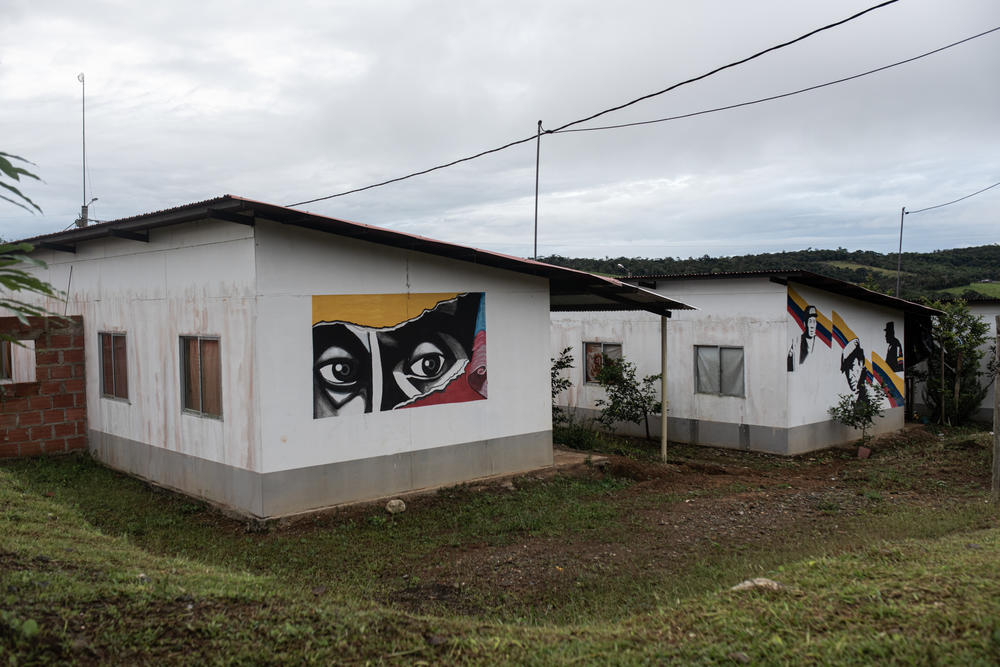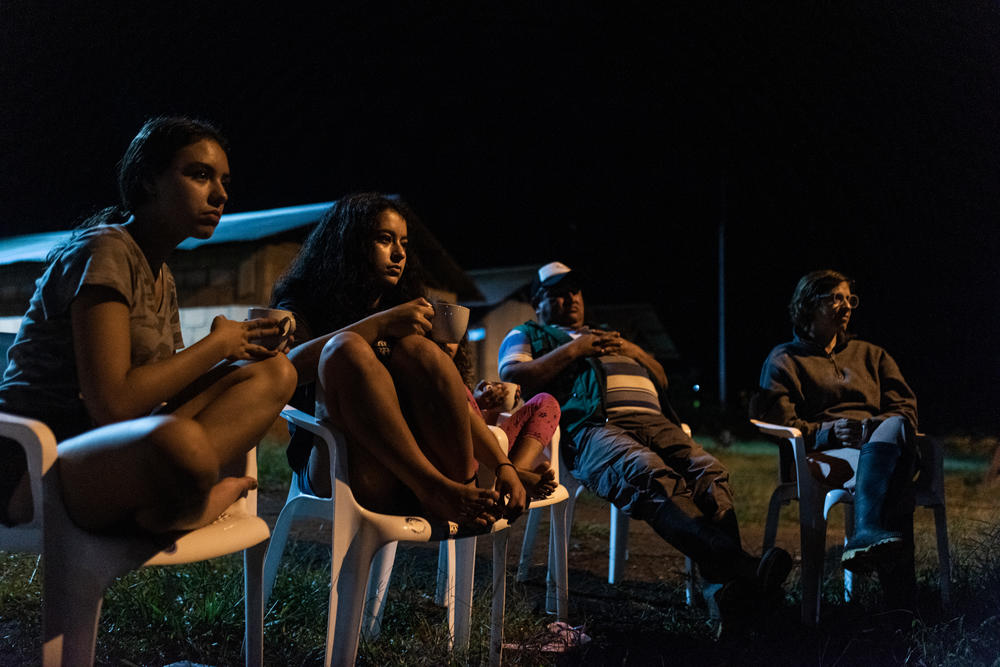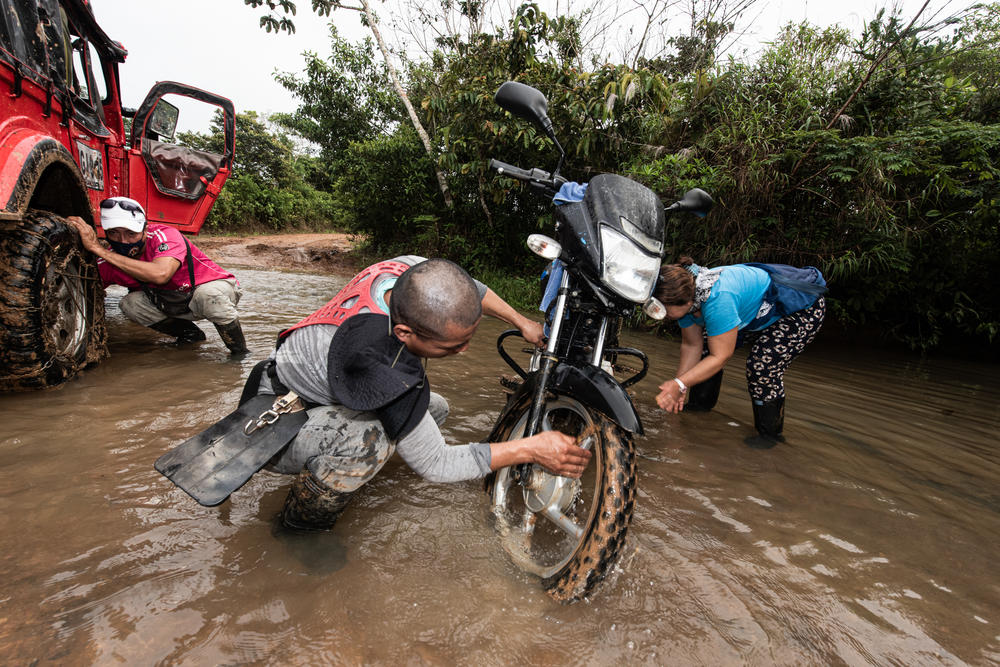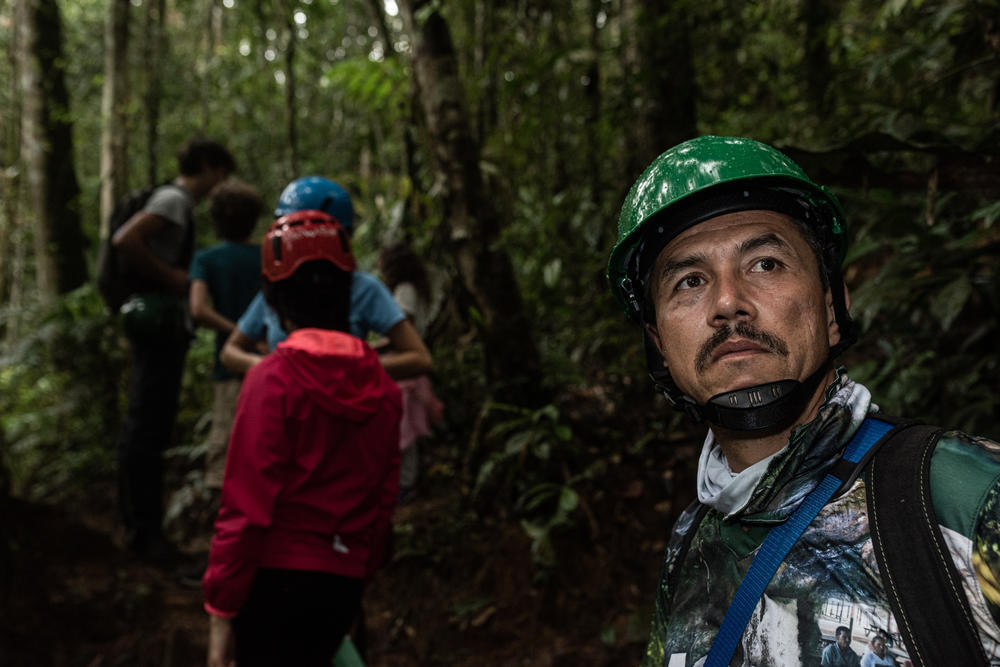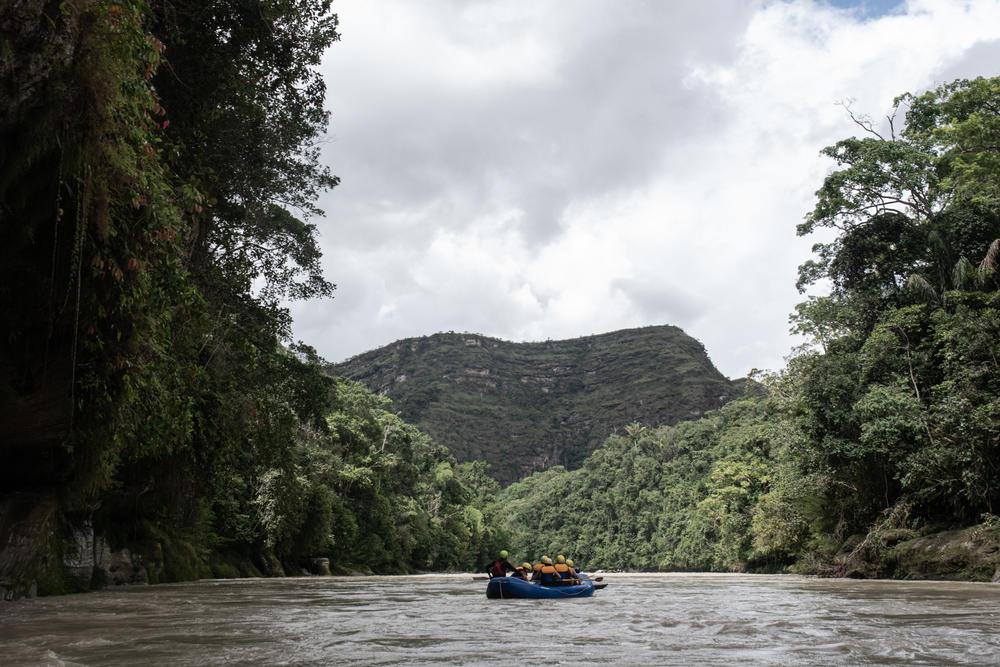Section Branding
Header Content
Tourists In Colombia Can Now Take Jungle Hikes With Ex-FARC Guerrilla Guides
Primary Content
MESETAS, Colombia — I'm with a small group of tourists preparing to rappel down a 150-foot canyon next to a waterfall in southern Colombia. It's scary, but we're in good hands, with guides intimately familiar with this jungle terrain.
That's because the guides patrolled here years ago as members of the Revolutionary Armed Forces of Colombia, a Marxist rebel group known as the FARC. In fact, to escape from army troops, the rebels sometimes rappelled down cliffs like these using nothing more than tree vines — though for us tourists, they provide the requisite ropes and safety harnesses.
"These were things you had to do during the war to save your life," says Lida María Urrego, a FARC guerrilla turned guide who still goes by her nom de guerre, Daisy.
The war is now over, thanks to a 2016 peace treaty that prompted 13,000 FARC fighters to lay down their weapons. But many of them lacked skills to secure jobs in the cities. After benefiting from courses in tourism and hospitality at a state-run vocational school and funding from the Norwegian government — an enthusiastic supporter of the peace process — about 30 ex-combatants set up a tourism agency in 2018. They now give visitors a taste of what their lives were and are like, at a cost of about $125 per guest for a weekend junket.
Located in Mesetas, a town in what was once rebel-held territory, Catypsa Expeditions takes tourists rafting, rappelling and trekking.
The FARC's fearsome reputation isn't deterring tourists
Félix Sanabria, a former FARC guerrilla who heads the agency, says the rebels saw the region's ravines and river valleys as hiding places and perilous obstacles that had to be crossed while carrying rifles and backpacks filled with 70 lbs. of ammunition and gear.
"The truth is I never imagined that this would become a tourist attraction," he says, smiling.
He's not the only one pleasantly surprised. Colombia is home to snow-capped Andean peaks and lush Amazon jungle, but for decades, few tourists ventured into these regions, due to the guerrilla war that began in the mid-1960s and lasted more than 50 years.
Then, too, there was the FARC's fearsome reputation. The guerrillas funded their war by trafficking cocaine, extorting businesses and kidnapping civilians. Their abductees were sometimes chained up in the jungle for years until their families forked over large ransom payments.
The former guerrillas insist that they were fighting for land reform and to improve conditions for Colombia's poor. Sanabria, who admits to having taken part in kidnappings, remains proud of his guerrilla past. He claims the FARC's war atrocities haven't scared away visitors.
"Tourists want to hear directly from us why we went into the hills to fight and what we're up to today," says Sanabria, who is now 52 and joined the FARC when he was 12. "No one has said they don't want to be with us because we used to be guerrillas."
Spartan accommodations in a bucolic jungle setting
Between 2006, when the intensity of the war was near its peak, and 2019, the number of foreign visitors to Colombia grew by 300%. Like other tourism agencies, Catypsa was dormant during the worst of the pandemic, but the company is now reopening, hosting a handful of tourists on weekends.
Accommodations are spartan. Rather than at a hotel, we bunk down at one of several resettlement camps the Colombian government set up around the country to help former rebels transition to civilian life. Getting to our camp requires a two-hour journey from Mesetas over roads so muddy that the driver stops our decades-old Soviet-made SUV to put chains on the tires.
The camp's rustic buildings are decorated with revolutionary graffiti and pictures of rebel icons like Ernesto "Che" Guevara. It's named after Simón Trinidad, a FARC commander imprisoned in the U.S. for his role in kidnapping three U.S. military contractors in 2003.
The setting is rather bucolic. The camp's 80 residents tend yuca and other crops in the surrounding fields and look after children scurrying about the camp. The only blood spilled comes when several former rebels decapitate chickens for our evening meal.
Tough questions and tearful answers
At night, we sit around a campfire as Marco Alvis, a former FARC commander, fields our questions about the war. Bogotá high school student Manuela Jiménez asks if Alvis has ever killed anyone. He responds that amid the chaos of combat, it was impossible to tell.
Then comes another tough question: Why did the FARC kidnap so many people?
Rather than explaining, Alvis suddenly tears up and apologizes and asks our forgiveness for the abuses the rebels committed during the war. Under the peace process, former rebels have been carrying out similar acts of atonement with war victims throughout Colombia.
Afterwards, Jiménez, the high school student, reflects on what she's seen and heard.
"I've heard all my life that 'FARC did this, FARC did that.' They kidnapped people. And now you see them asking for forgiveness and wanting to make up for everything they've done," she says. "I don't think they can make up, exactly. But I think if they continue to do this tourism, that it's really nice. They want to share paradises that have never been seen because of war."
Among the hidden gems is the Pato River, about 100 miles south of Mesetas, where another group of former FARC combatants takes tourists rafting. Its guides have become so skilled in whitewater that five took part in the 2019 World Rafting Championship in Tully, Australia.
Another is that cliff next to the waterfall we're about to rappel down.
Jiménez's mother, Margarita Martinez, has never rappelled before. But after she makes it safely to the bottom, she points out that the former guerrillas guiding her down have been surviving in the wilderness all their lives.
"Actually, it gave me much more confidence than just a regular guide who does a little training," she says. "It was better to be in their hands."
And with that, she starts back up the cliff to do it all over again.
Copyright 2021 NPR. To see more, visit https://www.npr.org.
